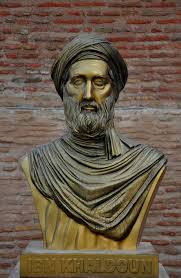Share This Article
Ibn Khaldun is the North African thinker and statesman who lived in the 14th century and
laid the foundations of historiosophy, sociology and economics. Even though the term
“sociology” is firstly used by the 19th century thinker Auguste Comte -who is accepted as the
founder of sociology by Western sources-, Ibn Khaldun has initiated sociology studies five
hundred years before Comte. He wasn’t aware of the science he initiated at the time, but after
centuries, today his works are considered under the frame of sociology literature.
Ibn Khaldun suggests that social, economic and political transformations include certain
patterns and they proceed in an order. He uses a science he named “umran” to explai his
suggestion. Umran deals with the reasons that necessitate to live together for, in other words
a community life, taking social life and organization of people in its center. According to
Khaldun, there are two reasons that motivate people to live together. First one is the need for
nourishment, which requires cooperation and solidarity. Second one is the need for defence
and protection, which requires sticking together.
The lexical meaning of Umran is to progress and improve. It has two forms: umran badawi
and umran hadhari. Badawi umran means nomadian and it refers to the most primitive
lifestyle. In this form, far from sciences; artisanship such as carpentry, forging, bakery didn’t
exist and even if they did, they existed as silhouettes. The need of cooperation and solidarity
necessitates a social life in badawi umran. The form, quality and quantity of this social
cooperation is expressed with the term “asabiyah”, which is considered as kindredship in
badawi umran. Badawi umran proceeds to hadhari umran. The main future of the transition
from badawi umran to hadhari umran is the increase of the production volume in badawi
umran. At this stage, another factor arises that oblige people to socialize and this factor is the
sovereign power that protects people and their excessive goods against each other and
regulates their relations. When it comes to the level of hadhari umran, it becomes overly
complex to be defined in terms of kindredship. However, since people continue to live
together, asabiyah haven’t disappeared yet but only gained a new meaning. For this form of
umran, in which complex city economies exist with industry and technology; fine arts,
elegant artisanship and science can find place state and asabiyah are indispensable.
According to Ibn Khaldun, umran shares the life of state in space and time. It improves when
state improves, it peaks when state peaks and it disappears when state disappears. Khaldun
suggests that, in the process which leads to states there is a relation between the form of
asabiyah and the shape the state will take. To explain this relation, there are five phases of the
state’s organizational development, from the perspective of the state as a political
organization.
1- Victory and Invasion: It’s the foundation stage of state or dynasty. It includes seizing the
power from its previous owner and founding the state/dynasty, by suppressing every sort of
resistance. Sovereign hasn’t separated parties that are involved in the foundation process and
the society, yet. Thus, parties who are closer to sovereign become a part of administration and
this indicates that the dynamism of asabiyah is at the highest level.
2- Domination: It’s the stage where the sovereign seeks to guarantee its domination over the
society and tends to centralize his power. The sovereign desires to cast the notables -who had
become a part of the administration- aside. Nevertheless, he wants to keep them loyal. He
achieves this by paying salary through civilian and military bureaucracies. However, casting
the parties aside, who he had been sharing the same asabiyah, would lead to dissolution of the
asabiyah and his own end.
3- Prosperity: This is the stage of wealth and comfort. At this period, the sovereign
completely hegemonized both his own group and the outsiders of his group. Now he has a
wide tax base and a well-functioning financial order, an effective civilian bureaucracy which
is responsible for enforcing his orders everywhere and a well-trained strong army. He makes
an effort to increase his personal wealth and financial resources of the state, urban
beautification and cultural development. All national subjects of the state benefit from this
economic prosperity.
4- Peace: In this stage development of the state stops. Sovereign is confined with what his
ancestors left. It’s the phase where the structure of the state becomes traditional and its
rationalist elements disappear. Additionally, a tendency of resistance for change exists and
the sovereign rarely answers external threats and developments.
5- Extravagance: The sovereign spends all the wealth his ancestors left prodigally for
pleasure. Thus, he demolishes the institutional structure of the states his ancestors established
and he causes dismemberment of the state. The group who holds the authority changes, the
sovereign changes and the asabiyah dissolves. The state can survive only if a dynasty shift
within the country occurs.
According to Ibn Khaldun, the most critical phase is the transition from prosperity stage to
peace stage when all the stages that the institutional structure of the state goes through are
considered. Since the cultural development of the society continues but a production
mechanism and economic structure to support this cultural development don’t exist, the trust
for the government weakens. Even if the society holds its cultural expectations back for a
while, a feeling of resentment appears after sometime because humans are cultural beings.
“Humans are the children of their habits, not their fathers.” with Khaldun’s words.
Consequently, just as all living beings that are born, grow, develop, age and die; according to
Ibn Khaldun, every social organization is alive in this context and they are established,
develop, age, dissolve and die.
This article is written by Merve Ilgaz and Beyza Kumanova



